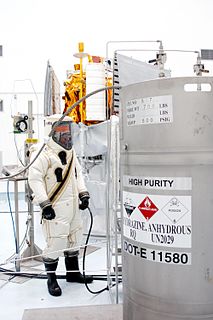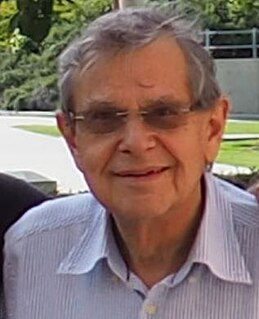
A rocket is a missile, spacecraft, aircraft or other vehicle that obtains thrust from a rocket engine. Rocket engine exhaust is formed entirely from propellant carried within the rocket before use. Rocket engines work by action and reaction and push rockets forward simply by expelling their exhaust in the opposite direction at high speed, and can therefore work in the vacuum of space.

A solid-propellant rocket or solid rocket is a rocket with a rocket engine that uses solid propellants (fuel/oxidizer). The earliest rockets were solid-fuel rockets powered by gunpowder; they were used in warfare by the Chinese, Indians, Mongols and Persians, as early as the 13th century.

A hybrid-propellant rocket is a rocket with a rocket motor that uses rocket propellants in two different phases: one solid and the other either gas or liquid. The hybrid rocket concept can be traced back at least 75 years.

A hypergolic propellant combination used in a rocket engine is one whose components spontaneously ignite when they come into contact with each other.

A rocket engine uses stored rocket propellant mass for forming its high-speed propulsive jet. Rocket engines are reaction engines, obtaining thrust in accordance with Newton's third law. Most rocket engines use combustion, although non-combusting forms also exist. Vehicles propelled by rocket engines are commonly called rockets. Since they need no external material to form their jet, rocket engines can perform in a vacuum and thus can be used to propel spacecraft and ballistic missiles.

A liquid-propellant rocket or liquid rocket is a rocket engine that uses liquid propellants. Liquids are desirable because their reasonably high density allows the volume of the propellant tanks to be relatively low, and it is possible to use lightweight centrifugal turbopumps to pump the propellant from the tanks into the combustion chamber, which means that the propellants can be kept under low pressure. This permits the use of low-mass propellant tanks, resulting in a high mass ratio for the rocket.

The Aerojet Rocketdyne RS-25, otherwise known as the Space Shuttle main engine (SSME), is a liquid-fuel cryogenic rocket engine that was used on NASA's Space Shuttle and is planned to be used on its successor, the Space Launch System (SLS).

The staged combustion cycle is a power cycle of a bipropellant rocket engine. In the staged combustion cycle, propellant flows through multiple combustion chambers, and is thus combusted in stages. The main advantage relative to other rocket engine power cycles is high fuel efficiency, measured through specific impulse, while its main disadvantage is engineering complexity.

The pressure-fed engine is a class of rocket engine designs. A separate gas supply, usually helium, pressurizes the propellant tanks to force fuel and oxidizer to the combustion chamber. To maintain adequate flow, the tank pressures must exceed the combustion chamber pressure.
Gary Arnold Flandro is an American aerospace engineer who currently holds the Boling Chair of Excellence in Space Propulsion (Emeritus) at the University of Tennessee Space Institute. He is also the Vice President and Chief Engineer at Gloyer-Taylor Laboratories (GTL).
Ammonium perchlorate composite propellant (APCP) is a modern solid-propellant rocket used in rocket vehicles. It differs from many traditional solid rocket propellants such as black powder or zinc-sulfur, not only in chemical composition and overall performance, but also by the nature of how it is processed. APCP is cast into shape, as opposed to powder pressing as with black powder. This provides manufacturing regularity and repeatability, which are necessary requirements for use in the aerospace industry.
In chemistry, the burn rate is a measure of the linear combustion rate of a compound or substance such as a candle or a solid propellant. It is measured in length over time, such as "mm/second" or "inches/second". Among the variables affecting burn rate are pressure and temperature. Burn rate is an important parameter especially in the area of propellants because it determines the rate at which exhaust gases are generated from the burning propellant which in turn decides the rate of flow through the nozzle. The thrust generated in the rocket of missile depends on this rate of flow. Thus Knowing quantitatively the burning rate of a propellant, and how it changes under various conditions, is of fundamental importance in the successful design of a solid rocket motor. The concept of Burning rate is also relevant in case of liquid propellants.

Waman Dattatreya Patwardhan was an Indian nuclear chemist, defence scientist and an expert in the science of Explosives engineering. He was the founder director of the Explosives Research and Development Laboratory of India. He is considered one of the distinguished scientists in India due to his contributions to Indian space program, Indian nuclear program and missile program in their early stages. He developed the solid propellant for India's first space rocket launched at Thumba. He was responsible for developing the detonation system of India's first nuclear device which was successfully tested in 1974, an operation codenamed Smiling Buddha.
Dr. Haridwar Singh was an Indian Emeritus Scientist. He has been Director of the High Energy Materials Research Laboratory (H.E.M.R.L), Defence Research and Development Organisation, (D.R.D.O), Ministry of Defence, from 1990 to 2004.
Rocket propellant is a material used either directly by a rocket as the reaction mass, or indirectly to produce the reaction mass in a chemical reaction. The reaction mass is that which is ejected, typically with very high speed, from a rocket engine to produce thrust.

KSLV-II, also known as Nuri (누리), is South Korea's second carrier rocket and the successor of KSLV-1. This three-stage rocket is entirely developed by the Korea Aerospace Research Institute (KARI), and planned launched into space in 2021. All stages will use indigenously developed rocket engines. The South Korean government is setting SpaceX as a role model, especially in making cheaper and reliable rockets for commercial launch service. The goal is to launch a 1,500 kg payload into a 600–800 km low Earth orbit (LEO) and 2,600 kg into a 300 km LEO.

M. C. Dathan is an Indian space scientist and former director of the Vikram Sarabhai Space Centre (VSSC). The Government of India honoured him, in 2014, by awarding him the Padma Shri, the fourth highest civilian award, for his contributions to the fields of science and technology. In May 2016, the Government of Kerala appointed MC Dathan as the scientific advisor to chief minister.

Gilmour Space Technologies is an Australian private space company with a subsidiary in Singapore. Headquartered in Queensland, Australia, the company is developing new hybrid-engine rockets and associated technology to support the development of a low-cost space launch vehicle.

Forman Arthur Williams is an American academic in the field of combustion and aerospace engineering who is Emeritus Professor of Mechanical and Aerospace Engineering at the University of California, San Diego,.

Vice Admiral Levering Smith was a United States Navy admiral. He is best known for his role in the development of the Polaris, Poseidon and Trident missiles for ballistic missile submarines.
















